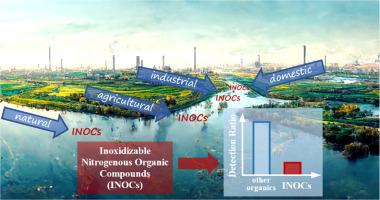可氧化的含氮有机化合物在评估水体有机污染中的漏报潜力:潜在机制
IF 6.3
3区 综合性期刊
Q1 Multidisciplinary
引用次数: 0
摘要
准确的有机污染评价在环境保护、行政管理和立法中具有重要作用。基于重铬酸盐的化学需氧量(CODCr)评价方法因其方便、简单和可重复性而被广泛应用于水体有机污染评价。某些含氮有机化合物的CODCr /理论需氧量(ThOD)比非常低,本研究将其称为可氧化含氮有机化合物(INOCs)。然而,人们对它们的普遍存在和内在特性却没有太多的关注。在此,我们旨在通过CODCr评估有机水污染时确定INOCs的低报潜力,并揭示这种低报的机制。CODCr仅报告了短链有机胺和吡啶衍生物理论值的0%-20%,因此对废水的处理和回收都提出了严峻的挑战。密度泛函理论计算表明,在酸性条件下,利用重铬酸盐为基础将inos转化为高度稳定的质子化/离子形式可能导致反应不完全,从而导致inos的潜力被严重低估。我们的研究结果可以作为政府、行业和其他利益相关者更有效地应对noc带来的挑战的基础。本文章由计算机程序翻译,如有差异,请以英文原文为准。

Under-reporting potential of inoxidizable nitrogenous organic compounds in assessing organic pollution of waters: Underlying mechanisms
Accurate assessment of organic pollution plays a vital role in environmental protection, administration, and legislation. Methodology involving the evaluation of dichromate-based chemical oxygen demand (CODCr) has been widely used for assessing organic pollution in water due to convenience, simplicity, and repeatability. Some nitrogenous organic compounds exhibit very low CODCr / theoretical oxygen demand (ThOD) ratios, which are termed inoxidizable nitrogenous organic compounds (INOCs) in this study. However, not much attention has been paid to their ubiquitous presence and intrinsic properties. Here, we aimed to determine the under-reporting potential of INOCs when assessing organic water pollution via CODCr and reveal the mechanisms underlying such under-reporting. CODCr reported only 0%–20% of the theoretical values of short-chain organic amines and pyridine derivatives, thereby posing severe challenges to both the treatment and reclamation of wastewater. Density functional theory calculations revealed that the use of dichromate-based transformation of INOCs to highly stable protonated/ionic forms under acidic conditions may lead to incomplete reactions, resulting in a significant under-reporting potential of INOCs. Our results may serve as a basis for governments, industries, and other stakeholders to respond more effectively to challenges posed by INOCs.
求助全文
通过发布文献求助,成功后即可免费获取论文全文。
去求助
来源期刊

Fundamental Research
Multidisciplinary-Multidisciplinary
CiteScore
4.00
自引率
1.60%
发文量
294
审稿时长
79 days
期刊介绍:
 求助内容:
求助内容: 应助结果提醒方式:
应助结果提醒方式:


